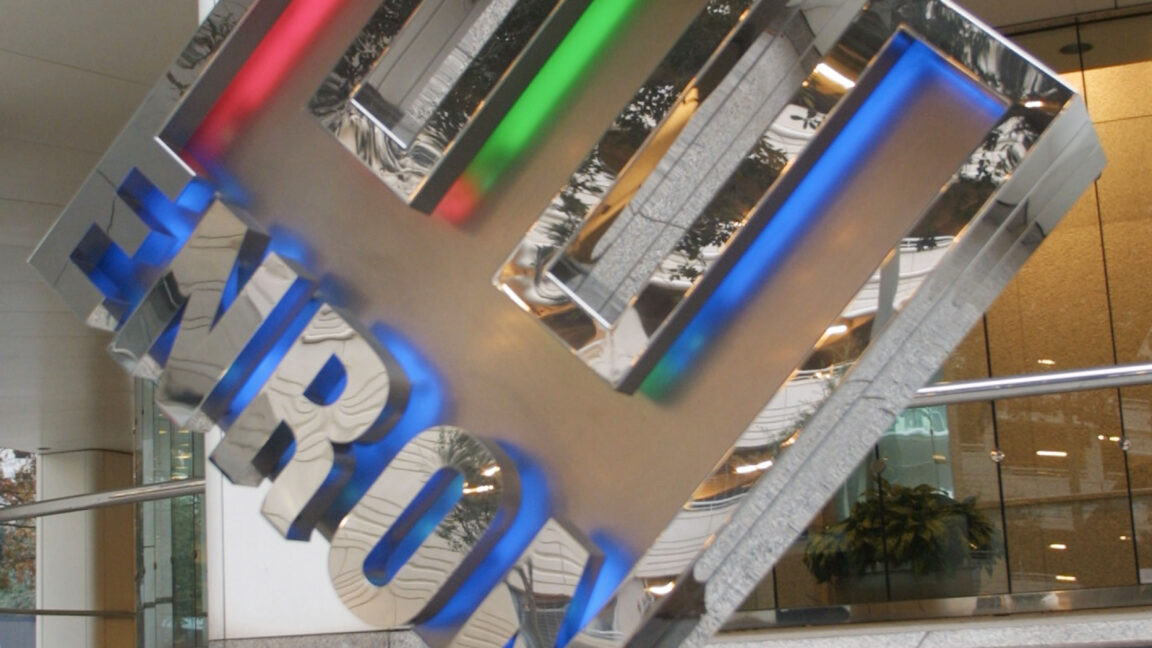Oh, Enron, I thought—hoped and dreamed?—you were long, long gone, confined to the dustbin of history reserved for seriously fraudulent companies.
But apparently not.
More than two decades after Enron's bankruptcy in December 2001, the company is back. Well, at least an entity using the website Enron.com went public on Monday, announcing Enron's relaunch as "a company dedicated to solving the global energy crisis."
On social media, the company posted a simple message: "We're back. Can we talk?"
I mean, I'd rather not. But you may be wondering—especially if you're under the age of 40—why this is news. Moreover, why is Ars Technica's space editor writing about it? Well, gather round the campfire for a little bit of history, my friends.
What Enron was
A quarter of a century ago Enron was a titan of US industry. It was this amazing Houston success story that revolutionized the trading of energy as a commodity and did a lot of other cutting-edge things like trading bandwidth, delivering home video, and essentially seeking to own the Internet. It began to report incredible revenues in excess of $100 billion a year, and the company's chief executive, Ken Lay, was among the most prominent people in Houston, where I live.
Only it all turned out to be this huge fraud. It was bigger than the Theranos scandal, before Theranos existed. Wikipedia does a nice job of summarizing what went down: "Enron's reported financial condition was sustained by an institutionalized, systematic, and creatively planned accounting fraud."
Yep, pretty much. It all unraveled quickly at the end of 2001.
Lay died of a heart attack while awaiting sentencing for being found guilty on multiple accounts of conspiracy and fraud. The firm's president, Jeffrey Skilling, was convicted of conspiracy, insider trading, securities and fraud. He served 12 years of a 24-year sentence before being released from prison in 2019. Chief financial officer Andrew Fastow received six years in prison after cooperating with federal authorities. One of the "big five" accounting firms, Arthur Andersen, was dissolved entirely for its part. It was all a big hullabaloo, and the Enron scandal became a cautionary tale.
Riding the rollercoaster down
At the time I was a 20-something reporter at the Houston Chronicle. I'd just gotten the beat I wanted—covering science—for a major daily newspaper. On the day the company filed for Chapter 11 bankruptcy, the paper's city editor, Wendy Benjaminson, came up to me and said, "Berger, you're good with numbers, aren't you?" With that, she assigned me to drop the science beat and cover Enron's bankruptcy proceedings.
And so I did. I flew to New York City twice a month for hearings. It was an eerie time in the southern end of Manhattan, just weeks after the September 11 attack. The hearings themselves were dreadfully boring. I had never covered a court case and knew next to nothing about bankruptcy law.
There wasn't much to go on. The lawyers for Enron were arrogant jerks, and the $500-and-up hourly rate they were charging the company did not include returning telephone calls from reporters. This experience consumed the better part of two years, but I achieved some pretty awesome status levels on Continental Airlines, at least.
Eventually, I came back to science writing and, about a decade ago, decided I wanted to cover space full-time and joined Ars in 2015. I had almost completely forgotten about Enron until the 'news' that Enron was relaunching itself.
So what’s really happening?
The company's new website is entirely bland, nothing but vague promises and values. A news release offers only a little bit more information, saying things like Enron has a "renewed commitment to integrity" and will focus on "solving the energy crisis."
Although there's nothing specific about it in the company's newly released information, it sounds like the relaunched Enron will create some token or coin to support energy sustainability.
I reached out to the company's press contact and asked for more information about this and whether the new Enron had bought the old Enron name. A quick reply came from Will Chabot, who said, "We'll have more to share soon and will be sure to keep you in the loop. Right now we have no additional comment beyond the press release." Despite the similarity of his name to chatbot, Chabot does, in fact, seem to be a real person.
Honestly, it's difficult to know what is going on here. In the website's terms of use, there is a comment that references the site as "protected parody, represents performance art, and is for entertainment purposes only." Also, this isn't actually Enron's original domain. It still exists here. So maybe it's all a lark?
Nevertheless, if there is an effort to sell cryptocurrency here, well, I can say it does seem on brand for the crypto industry to associate with Enron. There was a ton of hype at that company, too.
As for solving the energy crisis, the crypto justification for energy is that when renewables overproduce, cryptocurrency mining can soak up the excess. At the same time, it can be shut down when the grid is near its limits. However, the reality is that the same can be said for batteries, and batteries actually improve the use of renewable energy. Most of the time, cryptocurrency creates an excess demand that’s filled using fossil fuel plants that would not be active if crypto didn’t exist.
Anyway, Enron is back, I guess—just in time for the holidays.
Read full article
Comments




